This Is How Horticulturists Grow Broad Beans As An Early Summer Favourite

VEGETABLES > BROAD-BEANS
Reviewed By COLIN SKELLY

Colin is a Horticulturist and Horticultural Consultant with experience in a range of practical and managerial roles across heritage, commercial and public horticulture. He holds the Royal Horticultural Society’s Master of Horticulture award and has a particular interest in horticultural ecology and naturalistic planting for habitat and climate resilience.
IN THIS GUIDE
Grown by early humans many thousands of years ago and now going stronger than ever, Broad Beans are an early summer favourite.1Vicia faba. (n.d.). Oxford University Plants. Retrieved March 13, 2023, from https://herbaria.plants.ox.ac.uk/bol/plants400/Profiles/UV/Viciafaba
These tasty treats are oh-so-easy to grow and are also equally easy to prepare in the kitchen and are available in many varieties, each with its own merits.
This legume, called Fava Beans in North America and also Faba Beans, is popular just about everywhere on all continents bar Antarctica and is cooked and consumed in myriad ways.2Fava Beans. (n.d.). University of California. Retrieved March 13, 2023, from https://sfp.ucanr.edu/pubs/brochures/favabean/
Its Botanical name Vicia faba indicates its membership in Family Fabaceae which includes all the legumes, beans, and peas.3Broad bean. (n.d.). Plant Village. Retrieved March 13, 2023, from https://plantvillage.psu.edu/topics/broad-bean-dry/infos
Overview
| Botanical Name | Vicia faba |
| Common Name(s) | Broad Beans |
| Plant Type | Vegetable |
| Native Area | Mediterranean, Central Asia |
| Hardiness Rating | H4-H5 |
| Foliage | Broad, oval-shaped leaves |
| Flowers | White flowers with black spots |
| When To Sow | February, March, April, May, October, November |
| Harvesting Months | June, July |
Sunlight
Preferred
Full Sun or Partial Shade
Exposure
Sheltered
Size
Height
0.5 – 1.8M
Spread
0.1 – 0.5M
Bloom Time
April – June
Soil
Preferred
Most Soil Types
Moisture
Moist but well drained
pH
Any
Fava Beans are just about the only beans in Genus Vicia, colloquially called the ‘Vetches’.
Various Vetches or Vicia species are eaten in the wild by ruminants.
They are an easy-grow fodder for livestock and also serve as ‘green manure’ for the replenishment of depleted soil.
V. faba is an annual with an upright habit though most varieties are not stiffly upright.
As the more genteel and refined members of the very large, rough-and-tumble Vetch Family, V. faba lack any tendrils with which to grasp and clamber over other herbs and shrubs.

In windy regions they frequently bend or flop over.
For a plant that is valued for its vegetables, V. faba bears unusually pretty, even ornamental, flowers; what is more, they are very fragrant.
“I love broad beans for the delicious early crop of beans but also because they look great,” says Colin Skelly, who has been awarded the RHS’ Master of Horticulture status.
“I grow cultivars called ‘Crimson Flowered’ (spring sown) and ‘Superaguadulce’ (autumn sown).
“The latter provide an early crop of beans and the latter really attractive flowers and a delicious later crop.”
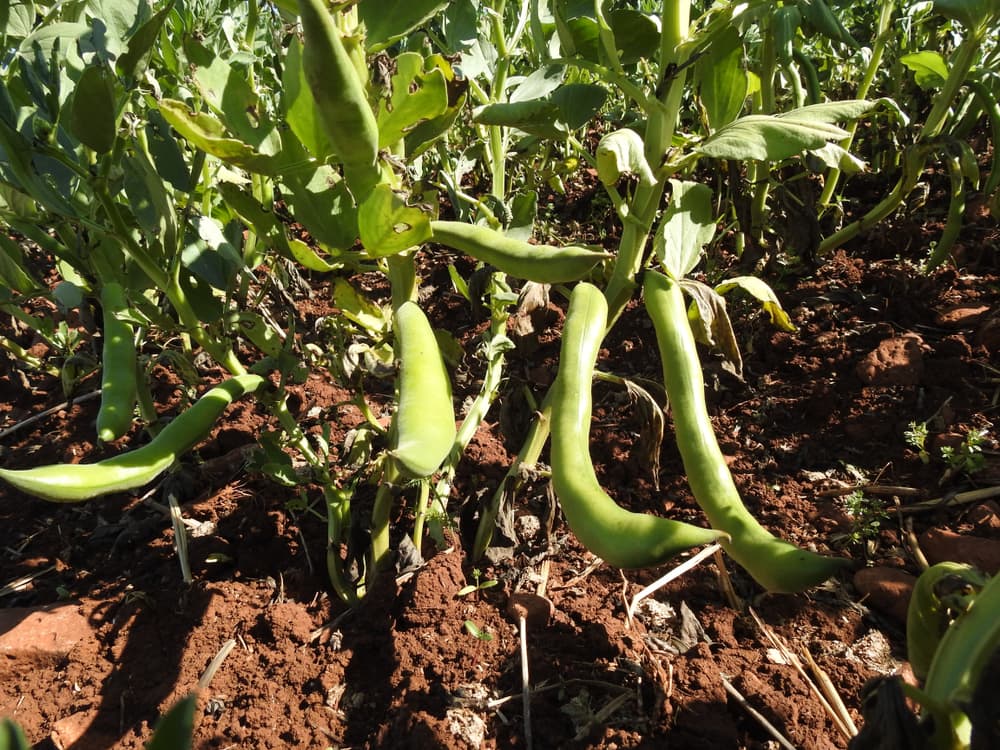
Like other plants in the Pea Family, its flowers have irregular corollas of Papilionaceous form.
The corolla comprises of two lower ‘keel’ petals, two outer ‘wing’ petals, and an upper ‘banner’ petal.
These petals are usually white or very light and have two very dark, often black, spots on the wing petals, and finely-etched lines on the banner petal.
Habitat & Growing Conditions
Though the Vicia genus is a rugged one with most species growing in poor soils and withstanding inhospitable conditions, Broad Beans – which, after all, are a domesticated species – are certainly not rough and tough like their country cousin vetches.
Soil Requirements
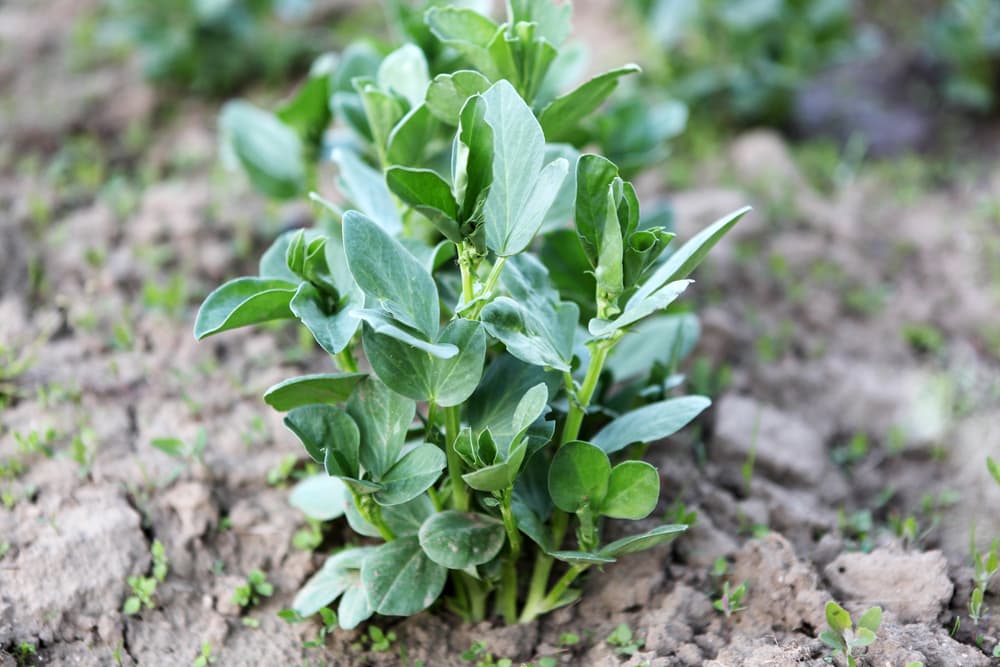
These plants flourish in full sun and in rich soil that has good drainage and contains ample organic manure.
Taking a (well-drained) bed of a fertile loam mix, spreading a light layer of manure over it, and mixing it in will provide excellent soil for Broad Beans.
Do not sow Broad Bean seeds in clay-rich soil as the seeds will likely rot and not germinate.
The ideal pH is between pH 6.0 and 7.0 – Slightly Acidic.
Shelter & Temperature
These plants need protection from high winds; accordingly, they should be grown in sheltered spots.
If no such location is available then a windbreak may prove necessary.

The ideal ambient temperature to grow Broad Beans is between 10 and 20°C. Soil temperature should not exceed 24°C.
Keep in mind that as a leguminous crop Broad Beans is a nitrogen-fixing plant that boosts the fertility of the soil it is grown in.4Nitrogen Fixation by Legumes. (n.d.). New Mexico State University. Retrieved March 13, 2023, from https://pubs.nmsu.edu/_a/A129/
Therefore, you can use the same soil the following year to grow such plants that need nitrogen-rich soil.

How To Grow Broad Beans
Sowing
You can sow Broad Beans seeds outdoors in late October or November for an early harvest.
Autumn-sown seedlings will germinate, overwinter outdoors, and start growing again in spring after the temperature crosses about 4.5°C.
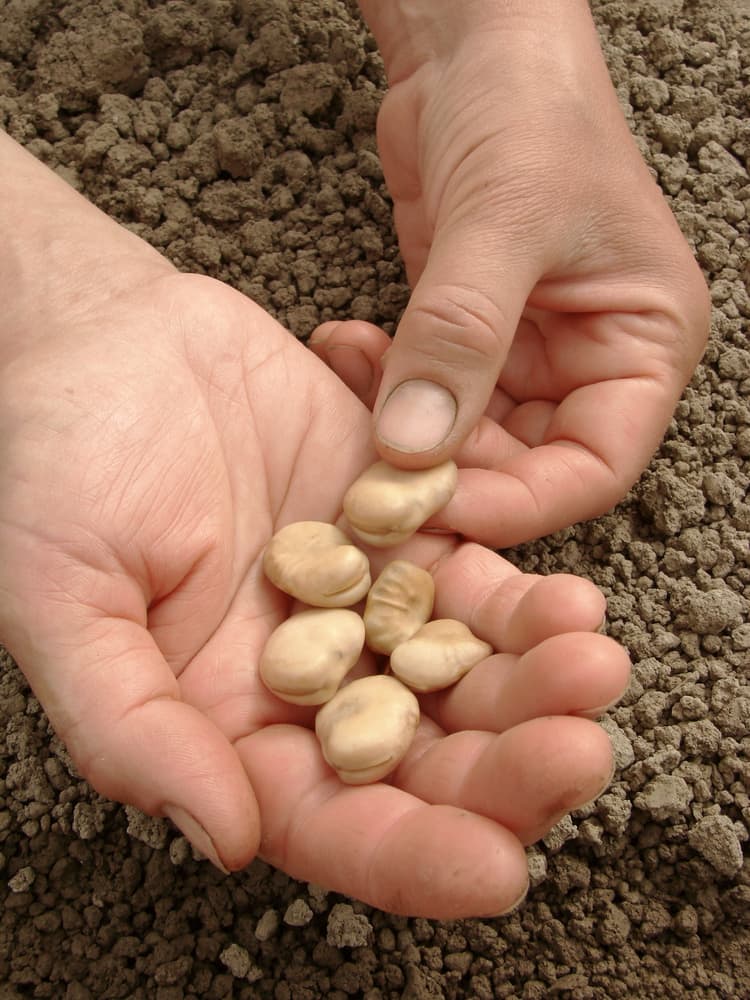
Many (though not all) varieties’ seedlings will be fine so long as they are in a sheltered spot with Southern exposure.
Otherwise, you will have to protect them with fleece or cloche or germinate them indoors or in a greenhouse for later transplanting.
To grow in the easiest, most trouble-free way, sow seeds outside when the minimum temperature is no less than 4.5°C and daytime temperature crosses 10°C.
This will be sometime in April in most parts of England and Wales.
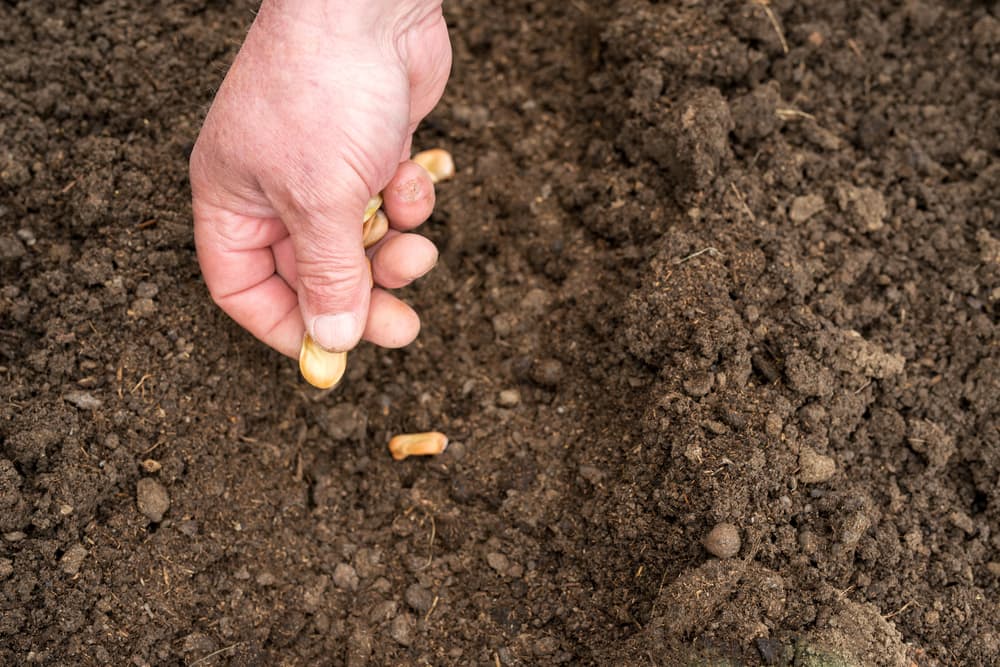
As a general rule, April is the ‘best’ month for sowing Broad Beans seeds (in England and Wales).
However, if the weather permits or your variety of Broad Beans allows, sow in March to reap early harvests.
As a general rule seeds should be sown 5-6cm deep, and about 20cm, give or take a few centimetres, apart.
However, the spacing can vary for some varieties that may need more space or could make do with less.

Seeds in the next row may be planted at a similar distance; about 20cm.
If you sow seeds in long rows in open ground, space each double row to give you sufficient space to walk along the rows to pick your beans, say about 50cm.
All the seeds will not germinate so if you wish, sow a few ‘spares’ in pots or wherever you have room to transplant in unoccupied spots.
Watering
Give the seeds a fair sprinkling of water; give them another sprinkling when you see the seedlings sprouting from the soil.
Water in the early part of the morning and be wary of overwatering.
In many regions of the UK natural rainfall is usually almost sufficient for Broad Beans.
Keep the bed clear of weeds.
Staking
Most Broad Bean varieties, as leguminous plants, need support stakes.
The best way to support these plants is to drive stakes into the soil front and back along pairs of rows.

If your variety is not stiff or if you live in a blustery location, tie nylon string low and also high from stake to stake diagonally so as to create a lattice or fretwork as seen from above.
This framework should be tight enough to provide support to the growing plant so that it doesn’t flop over yet also provide sufficient room for the plant to spread as it grows.
If your soil is not rich and fertile, feed the plants with a 5-5-10 organic fertiliser.
When the plants start to flower, water them well if rainfall has been insufficient so that the soil becomes wet. Do so weekly.
Pinching Out
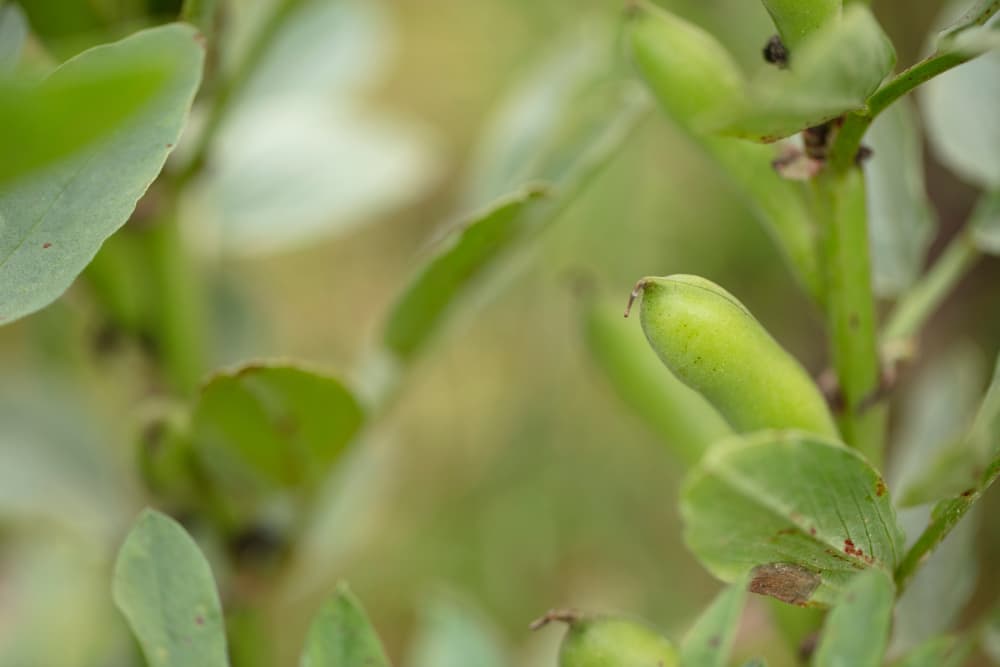
When the first flowers wither into charcoal-coloured slivers and the earliest little pods begin to take shape, pinch off the growing tips, alongwith the small bunch of young leaves, from the plants.
This pinching-off of the growing tip will stop the plant from growing bigger and its energies will be redirected into making bean-pods.
As a bonus, it will reduce the chances of black fly and aphid infestation.
Harvesting Broad Beans
You should be able to pick Broad Beans by early June onwards.
Do not let Broad Bean pods mature on the plant; pick them on the early side. Harvest pods young; pick a pod as soon as it is visibly swollen with beans.
There is no ‘right length’ at which to pick pods as different varieties’ lengths vary quite widely.

Run early experiments to figure out what is the best ‘length’ at which to pick pods on a particular variety you are growing.
This will depend on your personal taste and also on how you intend to cook and consume the beans.
As a general rule, pick lower pods first.
Do not pull the pods or cut them, but twist them off with a smart flick of the wrist.
Pods should be shelled when the seam or scar is whitish or a light shade of green and before it darkens.
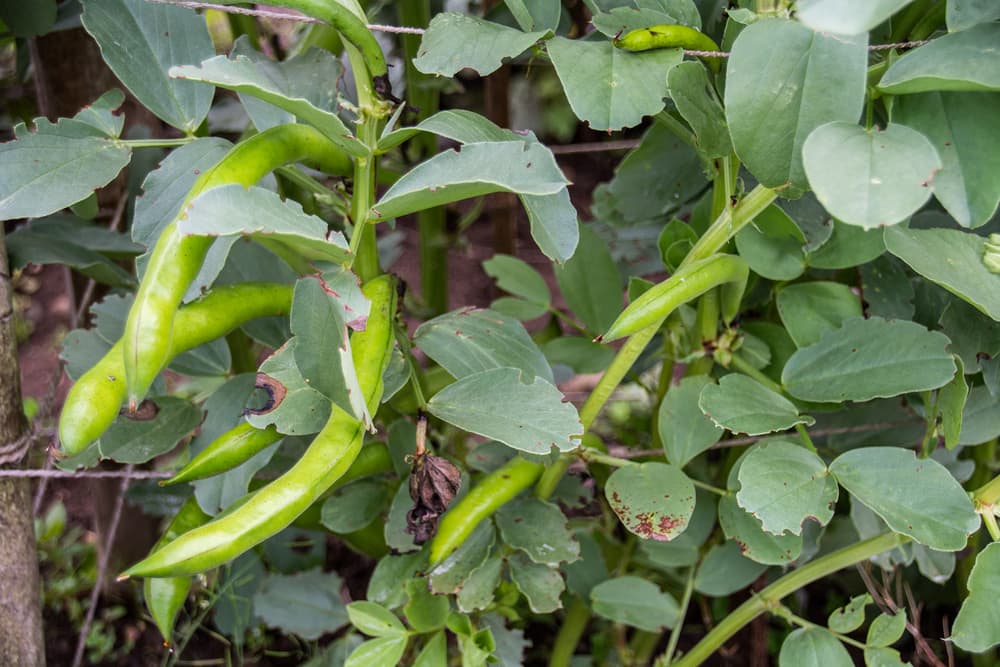
Otherwise the beans will lose their freshness and flavourfulness and become stringy, tough, or mealy.
Pods can be picked very young and cooked with beans in-pod, or the small, tender beans can be tossed raw in salads.
Common Problems
Spring-sown Broad Beans may suffer from Blackfly aka Black Bean Aphid and Pea and Bean Weevil.
See our guide to blackfly on broad bean plants for more information on how to diagnose and deal with this issue.
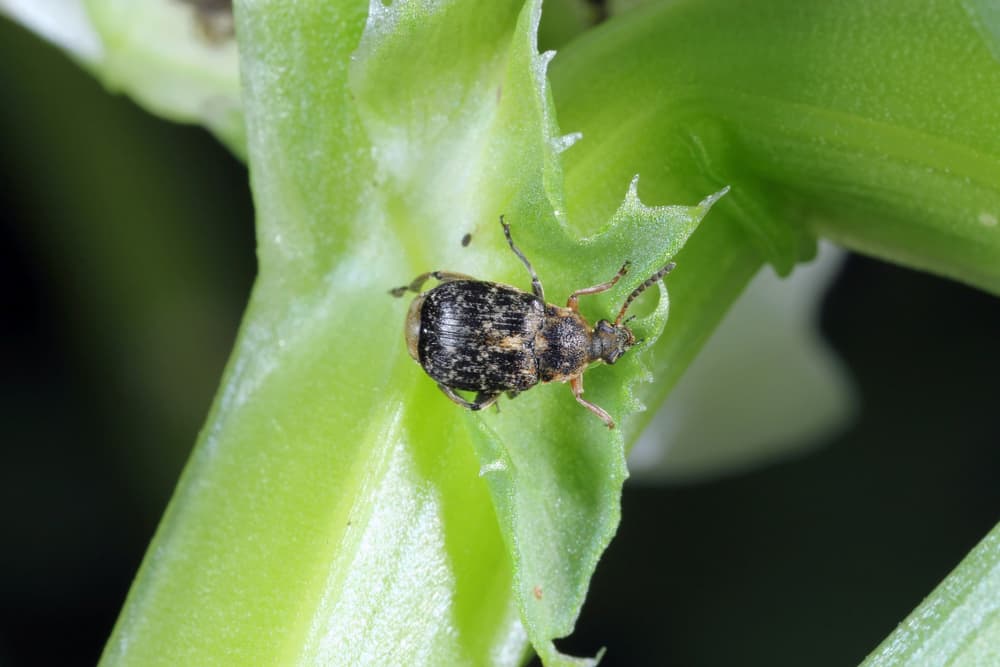
Pea and Bean Weevil cause cosmetic damage to leaves but do not affect the mature plant as a whole or its crop.
If this pest attacks seedlings or very young plants, then growth can be affected.
Chocolate Spot is not uncommon in plants that overwinter outdoors or in humid weather but it is much less common on spring-sown plants.
References
- 1Vicia faba. (n.d.). Oxford University Plants. Retrieved March 13, 2023, from https://herbaria.plants.ox.ac.uk/bol/plants400/Profiles/UV/Viciafaba
- 2Fava Beans. (n.d.). University of California. Retrieved March 13, 2023, from https://sfp.ucanr.edu/pubs/brochures/favabean/
- 3Broad bean. (n.d.). Plant Village. Retrieved March 13, 2023, from https://plantvillage.psu.edu/topics/broad-bean-dry/infos
- 4Nitrogen Fixation by Legumes. (n.d.). New Mexico State University. Retrieved March 13, 2023, from https://pubs.nmsu.edu/_a/A129/

